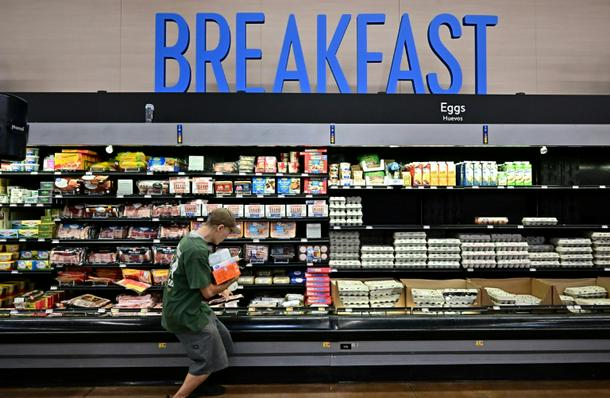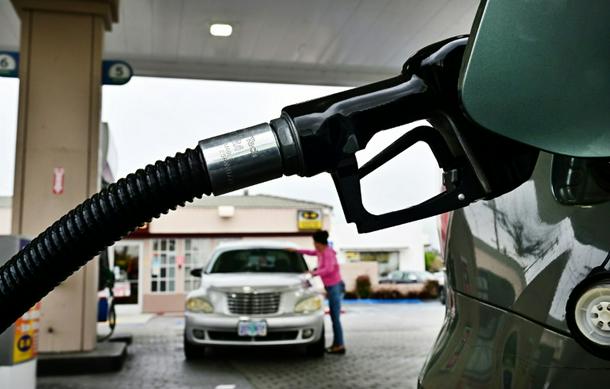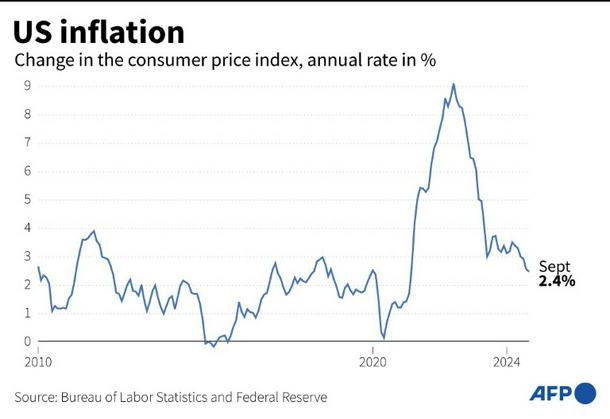
Economists had expected the US economy to grow by an annual rate of 3.0 percent in the third quarter, according to a consensus forecast
Washington (AFP) - The US economy saw resilient growth in the third quarter despite a modest slowdown according to government data Wednesday, less than a week before inflation-weary voters head into the presidential election.
The world’s biggest economy expanded at an annual rate of 2.8 percent in the July-September period, helped by consumption and government spending, although slowing from the second quarter’s 3.0 percent pace, the Department of Commerce said.
Despite spending more, American consumers have been downbeat about their job and financial prospects, with Democratic Vice President Kamala Harris trailing Republican Donald Trump in opinion polls about the economy.
But sentiment could improve with consumer confidence this month logging the strongest monthly gain since March 2021, according to The Conference Board on Tuesday.
“Today’s GDP report shows how far we’ve come since I took office – from the worst economic crisis since the Great Depression to the strongest economy in the world,” said President Joe Biden in a statement.
Critics thought a recession was needed to curb blistering inflation after the coronavirus pandemic, he added, but the US economy grew “around three percent a year on average, while inflation has fallen to the level right before the pandemic.”
- ‘Doing well’ -

Although US wages have grown, households are feeling the pressure from larger cumulative increases in areas they spend on, like food and gasoline, say analysts
The latest figure “sends a clear message that the economy is doing well,” said economist Ryan Sweet of Oxford Economics, adding that current trends lower risks of a sudden surge in layoffs.
US growth this year is due to outpace other advanced economies like Germany, France and the United Kingdom, the International Monetary Fund estimates.
But the third quarter figure came in slightly below an annual 3.0 percent rate expected in a market consensus published by Briefing.com.
The Commerce Department said the GDP figure reflected “increases in consumer spending, exports, and federal government spending.”
The deceleration from the second quarter was mainly due to a downturn in private inventory investment, alongside a bigger drop in residential fixed investment.
An October New York Times/Siena College poll of likely voters released last week showed that economic issues remained top-of-mind around two weeks before Election Day.
But those polled were slightly more inclined to trust Trump to do a better job handling the economy, with 52 percent of respondents preferring him to 45 percent support for Harris.
Harris said Wednesday she has a “specific and detailed plan about strengthening our economy.”
- Inflation ‘hard to swallow’ -

While US economic growth has been healthy, economists say the weight of cumulative inflation influences consumers' perspectives
“If you were to look at numbers like GDP growth or income or consumption, or even employment, you’d say: ‘Gosh, this economy is in pretty good shape,’” said Dan North, senior economist for Allianz Trade North America.
“The one thing that completely destroys that narrative is the inflation that consumers have had to deal with,” he told AFP.
North explains that as compared with January 2021, when price increases started ballooning, wages have cumulatively grown 18 percent.
But households contended with larger overall upticks on expenses like food, shelter and gasoline.
This is likely the reason that voters felt the economy is doing poorly despite job and wage growth, alongside relatively low unemployment levels.
“It’s been pretty hard to swallow,” said North.
Workers may have had 17 months of positive real wage growth, but they had 25 months of negative growth prior to that, ZipRecruiter chief economist Julia Pollak noted.
With people accustomed to positive wage growth prior to the pandemic, many still feel like their salaries need to catch up, she said.
On Wednesday, US private sector hiring also blew past expectations, in a sign of labor market resilience.
Meanwhile, consumers have been turning to credit cards and dipping into savings to fund spending, piling pressure especially on lower-income households and younger people.
Economists point to higher credit card delinquencies in recent times.
While analysts expect uncertainty surrounding the outcome of the US election could weigh on business investment in the fourth quarter, they do not anticipate a major impact.
The GDP growth figure is unlikely to sway the Federal Reserve’s interest rate decision next week much either, Nationwide chief economist Kathy Bostjancic told AFP.